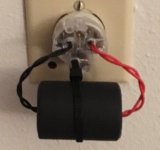Thanks Dan. That's actually the same little device I have and I've been using for a few years and recommending to people.
Here was my finding: when I went from hospital grade wall outlets to the Furutech GTX-D, the measured difference was 0% improvement - no change - (I do not own the NCF version). When I swapped out the Furutech wall outlets for the MIT Z-Duplex, I noticed a ~70% MEASURED reduction of EMI. When I then utilized four APC S20's, I saw a total 99.9% reduction of EMI, enabled common grounding and separation between components.
Regarding instantaneous current, the specs of the APC S20 show an output current max of 13 amps, which is ample provided you do not have any other devices on the S20 drawing power. That being said, current draw of an amp also depends on the particular amp. I can see McIntosh 2KW's easily drawing more than 13 amps! But, for most people, with most amps, 13 amps per amp is ample (holy cow, that's a lot of "amps" in there). It's also possible to find out the maximum amp draw for a particular amp. You will be surprised to learn many don't exceed 8 amps. For me, my flea powered amps probably don't draw more than 2 amps!

